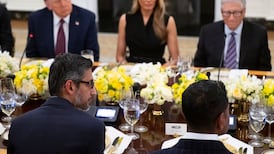There was much noise from Fianna Fáil about housing, health and broadband, but in the end, they decided to carry on supporting Fine Gael without a single new initiative to tackle any crisis. The as-you-were confidence-and-supply deal confirms that there is no difference between the two parties, beyond faux identities passed through generations.
They’re like rival clubs in the same county, inter-married and disliking each other in that most Irish way: by seeing the unpleasantness they recognise in themselves.
Both parties voted for each other’s twin horrors of the crash. Fine Gael backed the Fianna Fáil bank guarantee. Fianna Fáil supported Fine Gael’s vulture fund sell-off, the greatest transfer of property ownership since the Land League.
Ideologically they’re the same. Allow the property market to roam free, let multinationals pay as little tax as possible. Look at the recent history of their handling of Garda reforms from ignoring the Morris tribunal recommendations to ignoring the Garda Inspectorate report.
The parties truly believe they have separate identities. Some point to history and tribalism as the major chasm, but in 2018 no one cares about either, least of all the parties themselves.
History is for photo ops and making speeches to take potshots at rivals (as Leo Varadkar did in April while marking the anniversary of the Republic and as Micheál Martin did at Arbour Hill, within days). Tribalism is just for slagging on the canvass and one-upmanship on TV and radio panels. Both parties even look the same, dominated by middle-aged men.
They have similar levels of unmentionables. For every Haughey and Bertie mired in tribunal ickiness, Fine Gael has a Lowry and a Liam T Cosgrave. Fine Gael was always seen as the party of the wealthy elite in the city and the big farmer in the country. Yet its second most powerful figure is Paschal Donohoe from working class Phibsborough, with apologies to the invisible prince Coveney.
A big house
Enda Kenny didn’t come from a big house known for its trees either. Similarly Fianna Fáil identifies as the champion of the provincial underclass. Sandymount SC Jim O’Callaghan puts paid to that notion. Each time you see an example of the a typical Blueshirt or Soldier of Dynasty, examples abound that offset it. These are two broadly mixed parties, because they are the same.
They both detest the Shinners with equal vigour. Martin says the party is “cult-like” and not fit for office, while Varadkar says it’s “sectarian”. Both agree that despite Government Buildings being too good for Sinn Féin, Stormont and Westminster are not and they should share power with the DUP and take their seats in the Commons.
Often the differences are tactical efforts to feign a contrast, but the vision is always the same
Fine Gael’s Project 2040 cut-and-paste from Fianna Fáil’s history showcases how they mimic each other in power. Varadkar’s penchant for commenting on intractable issues as a spectator rather than someone with responsibility is straight from Project Bertie 1997-2008. The unequal economic recovery is down to Fine Gael implementing a plan of austerity imposed on Fianna Fáil by the troika, followed by both to the letter.
Varadkar didn’t want a presidential election, neither did Martin. Martin supported repealing the Eighth Amendment, ditto Varadkar. Varadkar backs journalism, Martin cherishes it also, but neither want to do anything about media ownership or defamation reform. Varadkar has not only parroted Martin’s policies, he’s mirrored his fitness and personal health regime and is now even copying his hairline.
The only thing that separates these parties is the fear that merging would end their reason to exist, hand the Opposition to Sinn Féin and kill off a club rivalry they enjoy so much that friendships and romances are formed more readily across party lines than within them.
Minute differences
There are minute differences in policy here and there, tiny steps across the same floor, a percentage here, a decimal there. Often the differences are tactical efforts to feign a contrast, but the vision is always the same. Let the markets and multinationals off to themselves. Over-rely on foreign direct investment for jobs and the economy. Make minuscule changes to budgets to make it seem as if they’re engaged in something. Do what Brussels says whatever the cost. Keep in with the yanks by fawning over every president and pretend we get something out of it. And slowly and glacially give way to social changes happening beyond Leinster House, which occasionally force them to act, then milking their sudden passion for the cause as though they alone are the heroes of reform.
Fine Gael and Fianna Fáil are the same. And there is no impetus to solve major public service crises without a real difference between the Government and the Opposition. It’s a shame the lefties can’t seem to get together and create an actual leftist party, not the diet socialism of Labour or the comically confusing hodgepodge of “others”.
Even Sinn Féin is creeping to the centre, which is a new name for the right, because they know their only hope of getting into government is to form a new club in the same county as the others.
Oliver Callan is a writer and satirist











